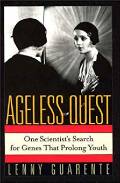Cynthia Kenyon Finds That Mutations In Daf-2 And Daf-16 Genes Cause C. Elegans Worms To Live Over Twice As Long
 Who:Cynthia Kenyon, Jean Chang, Erin Gensch, Adam Rudner, Ramon Tabtlang
Who:Cynthia Kenyon, Jean Chang, Erin Gensch, Adam Rudner, Ramon TabtlangWhen:September 15, 1993
Methods: By regulating the formation of a dauer state, and observing how long the daf-2 mutated strains lived compared to other strains.
Institution: University of California at San Francisco
Where: San Francisco, California, U.S.A
In 1993 Cynthia Kenyon's lab at UCSF reported that the mutation of two genes could cause a remarkable increase in the lifespan of nematode worms: Caenorhabditis elegans.
Both daf-2 and daf-16 regulate dauer state formation. The dauer state is a low-energy state used to survive times of starvation or over-crowding. Kenyon and her team managed to prevent the worms from entering dauer state by moving the worms to non-permissive temperatures.
Based on this result Kenyon theorizes that increased longevity during dauer state does not occur as a result of decreased activity but perhaps because of some genetic or molecular cause not yet understood. The worms which lived longer also proved to be more resistant to starvation and dessication.
References
- Cynthia Kenyon, Jean Chang, Erin Gensch , Adam Rudner, and Ramon Tabtiang. A C. elegans mutant that lives twice as long as wild type. Nature 366(6454), 461-464 (1993)
Links




